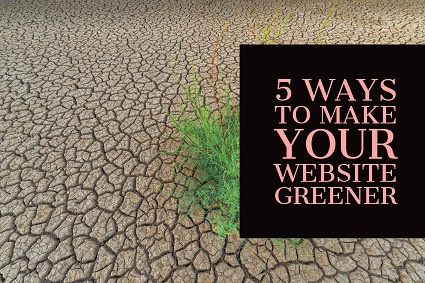Your cart is currently empty!

6 Steps to a Green Website
Is your website green? We’re not talking about literally green websites here, though this is the year for them, but about eco-friendly websites. You’re already making a green choice by using digital marketing rather than print, but you can be even more environmentally friendly by choosing a green website.
6 steps toward a green website
- Choose environmentally responsible hosting. WPEngine, GreenGeeks, Fat Cow, and DreamHost are just a few options. Check with the hosting company you’re considering and make sure they’re doing their best to keep their carbon footprint small. At the same time, make sure they can meet your needs and keep your website safe. This is the biggest potential energy savings.
- Choose a light website design. A simpler design with fewer calls to the server takes up less energy. Fewer animations and other fancy stuff also reduce energy use. Bloated code takes up more resources than needed. And, while it used to be the other way around, modern hardware uses more energy to show a dark-colored website than a light-colored one. The same changes that support sustainability also give you a fast load time, so this is win/win.
- Keep your content light. Words don’t take up a lot of resources, so have plenty of those. Then make sure you resize your pictures before uploading them. Try to embed videos rather than uploading them whenever possible. and avoid using builders for blog posts. Rely on good design and valuable content and limit bells and whistles.
- Make sure your pages are findable. Ecograder clarifies the connection: “The more findable content is, the fewer pages a person needs to click through to find what they’re looking for. Fewer pages loaded means that fewer server requests are made and fewer unnecessary page assets — like photos and videos, which take up a lot of bandwidth — are loaded. This results in small energy savings that add up over time.” In other words, the easier it is for your clients to find you, the better for the planet.
- Think about downstream use. Will people print out pages from your website? We know that patients often print out medical information to take to their doctors, and our doctor clients often print out pages from their websites to give to patients. If your visitors are likely to print, avoid dark backgrounds that will use up lots of ink, make printer-friendly versions of things people are most likely to print (recipes, for example, or illustrated workouts), and create PDFs for the pages you know you’ll be printing often.
- Think about your content management processes. Do you print out blog drafts and distribute them? Print documents out to work on, then scan and email your results? These are long-standing habits for some, but it’s worth trying to cut down on paper use for your content marketing initiatives. Use Edit Flow to replicate traditional content production systems electronically.
Sustainable practices are important, and not that difficult. Just going into your planning process with the environment in mind can help you make decisions that benefit the environment. Your clients and patients will appreciate your efforts.
by
Tags:

Leave a Reply